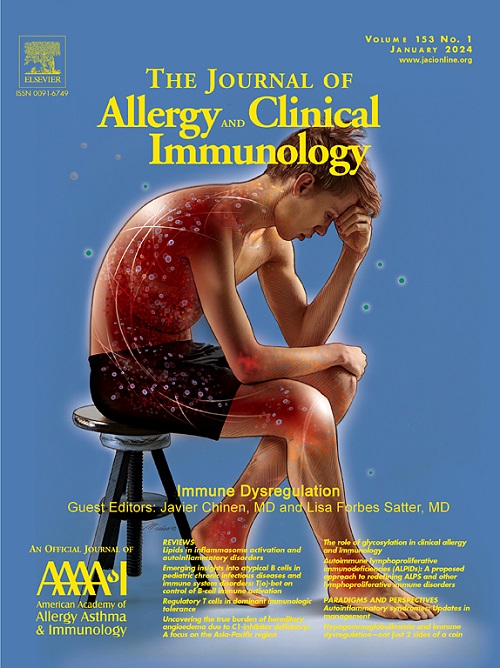Clinical and mechanistic advancements in aspirin exacerbated respiratory disease
IF 11.4
1区 医学
Q1 ALLERGY
引用次数: 0
Abstract
Aspirin-exacerbated respiratory disease (AERD) is characterized by the clinical triad of chronic rhinosinusitis with nasal polyps, asthma, and a hypersensitivity to nonsteroidal anti-inflammatory drugs (NSAIDs). AERD is estimated to occur in as many as 15% of patients with chronic rhinosinusitis with nasal polyps and/or asthma. Uniquely, patients with AERD develop respiratory symptoms within 30 to 180 minutes after ingesting NSAIDs such as aspirin or ibuprofen. However, even in the absence of NSAIDs, patients tend to have more severe upper and lower respiratory disease. The underlying pathogenic mechanisms contributing to AERD are complex and intertwined; they include a systemic dysregulation in arachidonic acid metabolism, an aberrant inflammatory response, a disruption in the respiratory epithelial barrier, and an imbalance between the formation and degradation of fibrin locally in nasal polyps. This review will highlight novel mechanistic findings contributing to the pathogenesis of AERD. In addition, recent advancements in the clinical understanding and management of patients with AERD will be discussed.
阿司匹林加重呼吸系统疾病的临床和机制进展
阿司匹林加重呼吸系统疾病(AERD)的临床特征是慢性鼻窦炎伴鼻息肉、哮喘和对非甾体抗炎药(NSAIDs)的超敏反应。据估计,多达15%的慢性鼻窦炎合并鼻息肉和/或哮喘患者会发生AERD。独特的是,患有AERD的患者在摄入非甾体抗炎药(如阿司匹林或布洛芬)后30至180分钟内出现呼吸道症状。然而,即使在没有非甾体抗炎药的情况下,患者往往有更严重的上、下呼吸道疾病。导致AERD的潜在致病机制复杂且相互交织;它们包括花生四烯酸代谢的全身性失调、异常的炎症反应、呼吸上皮屏障的破坏以及鼻息肉局部纤维蛋白形成和降解之间的不平衡。这篇综述将重点介绍有助于AERD发病机制的新机制发现。此外,还将讨论最近在临床对AERD患者的认识和管理方面的进展。
本文章由计算机程序翻译,如有差异,请以英文原文为准。
求助全文
约1分钟内获得全文
求助全文
来源期刊
CiteScore
25.90
自引率
7.70%
发文量
1302
审稿时长
38 days
期刊介绍:
The Journal of Allergy and Clinical Immunology is a prestigious publication that features groundbreaking research in the fields of Allergy, Asthma, and Immunology. This influential journal publishes high-impact research papers that explore various topics, including asthma, food allergy, allergic rhinitis, atopic dermatitis, primary immune deficiencies, occupational and environmental allergy, and other allergic and immunologic diseases. The articles not only report on clinical trials and mechanistic studies but also provide insights into novel therapies, underlying mechanisms, and important discoveries that contribute to our understanding of these diseases. By sharing this valuable information, the journal aims to enhance the diagnosis and management of patients in the future.

 求助内容:
求助内容: 应助结果提醒方式:
应助结果提醒方式:


